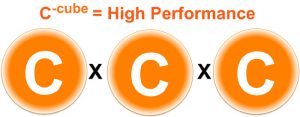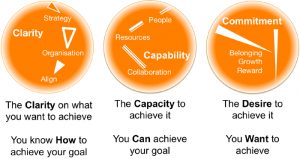My practice has enabled me to work with many organizations across various industries, countries and maturity levels. While I’ve facilitated and helped these organizations in several different aspects of leadership and human capital management, there’s one that often stands out as an area of intrigue and high importance. What I’ve often come across in most of these organizations is their desire and aspiration to enhance productivity and create a high performing organization. Unfortunately, a one-size-fits-all solution doesn’t exist which could be plugged into their culture and miraculously they’ll see results from it.
Having said that, having worked with organizations who have succeeded and failed at creating high performing teams I’ve managed to find a few common characteristics that are essential ingredients for achieving this goal. When I compared my findings with other high performance organization models I found that the themes are quite similar. This led me to create the C-Cube Framework of High Performing Organizations which captures the essence of how any organization can enhance productivity.
Now, every time I’m asked by a client how they can create a high performing organization I share this picture with them. Interestingly enough, when I inquire from the leaders and managers what the 3C’s represent I usually get a list of textbook feedback. Usually one or two of them are correct as well, however, the responses are restricted to Capacity, Culture, Customer, Collaboration, Coordination, Costs and so on. So, let’s unfold the mystery and share with you all what the C-Cube really stands for.
1. Clarity
To kick start your pursuit of creating a high performing organization you’ll need to clearly define:
- why you exist? (i.e. your organization’s purpose)
- what you do? (i.e. your core abilities)
- how you do it? (i.e. your values)
These three combined will help you device a clear plan on how to succeed, what your organization will look and feel like, what processes and governance frameworks will be in place and how your employees will behave. All of these are pretty core and the fundamentals of a high performing organization.
Once you’ve got this down, the most important and challenging component of the Clarity ‘C’ is to ensure that every member of your organization understands, accepts and lives and breathes by it. There’s no room for ambiguity as that can lead to resistance and friction that hampers the creation of a high performing organization. Everyone needs to be clear on their understanding of what the organization is aiming for and how they contribute and support the achievement of the overall purpose. It’s through clarity that you’ll be able to align your team with success.
2. Capability
So you’ve established what your organization is all about. Now’s the time to go out and achieve it, i.e. build the capability to deliver on your purpose and goals. So how do you do that? Some would say having the right people in the right place should suffice, but that’s not the case. Sure having a team of talented individuals is essence, but more than that you need to ensure that your people act and behave in a manner that’s consistent with your organization’s values. That’s what building capability is about. It’s probably the biggest contributor to your brand and how your customers and other stakeholders perceive it.
Building a brand that people can trust isn’t easy. But before you can go out and deliver exceptional customer experiences you’ll need to work on building trust internally. And that means building capabilities within your employees. Along with this, building capability also includes essential other resources such as funds, assets, tools, information and knowledge. And to use capabilities to your advantage you’ll need to create environments that foster creativity, collaboration and harmonious functioning, across the board.
3. Commitment
So you’ve laid down the building blocks of a strong and high performing organization. Will it work without passion, desire and commitment to the cause? Not really. To really transform into a high performing organization you need people with extreme passion and desire to succeed (and succeed with you). They’ll need to be restless to achieve the impossible and give it their all. You’ll need commitment that’s deep rooted in the hearts of your people. A commitment for excellence and a passion to achieve the organization’s purpose by making it their own. Once you employees are aligned and make it their personal mission to achieve success you’ll find that their commitment to the organization is unbreakable. And for that you’ll need to empower them and ensure them that their personal success is directly tied with the organization’s.
To really and truly create a high performing organization you need to accept that there are many moving parts that you’ll have to get right, all at the same time and all the time. Even with one missing component of the C-Cube Framework your ambition to create a high performing organization will fail. It’s an ongoing challenge to keep the C-Cube Framework actively engaged, but if you can, the result will most definitely equate to success.
Like what you read? Subscribe to the Keijzer Community and get updates to your inbox. You’ll also get a free download which will help you take your leadership teams through a growth model which will help them mature on a personal and professional level.





